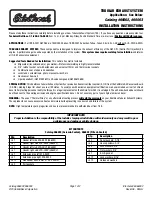
Things
to re
memb
er when
driving
82
Hills
To prevent overheating and reduced effi-
ciency of the brake system, drive long or
steep downhill grades in the gear in which the
least braking is required. Otherwise, even light
but continuous pressure on the brake can lead
to high temperatures, brake wear and possibly
even brake failure.
<
The braking action of the engine can be further
intensified by downshifting, all the way down to
first gear if need be. This strategy helps you
avoid placing excessive loads on the brake sys-
tem. Downshifting in manual mode of automatic
transmission, refer to page
. When descend-
ing hills slowly, use HDC Hill Descent Control,
refer to page
Never drive with the clutch depressed,
with the transmission in neutral, or with
the engine switched off; otherwise, you will
have neither the braking action of the engine or
nor its power assistance to the brakes or steer-
ing.
Never allow floor mats, carpeting, or other arti-
cles to protrude into the area around the brake
or accelerator pedals and obstruct their move-
ment.
<
Corrosion on brake rotors
When the vehicle is driven only occasionally,
during extended periods when the vehicle is not
used at all, and in operating conditions where
brake applications are less frequent, there is an
increased tendency for corrosion to form on
rotors, while contaminants accumulate on the
brake pads. This occurs because the minimal
pressure which must be exerted by the pads
during brake applications to clean the rotors is
not reached.
Should corrosion form on the brake rotors, the
brakes will tend to respond with a pulsating
effect that even extended application will fail to
cure.
Brake pads
The warning lamp lights up.
The brake pads have reached their min-
imum pad thickness. Have brake pads
replaced immediately.
Cargo loading
To avoid loading the tires beyond their
approved carrying capacity, never over-
load the vehicle. Overloading can lead to over-
heating of the tire and increases the rate at
which damage develops inside the tires. The
ultimate result can assume the form of a sudden
blow-out.
<
Determining load limit
1.
Locate the following statement on your
vehicle's placard
*
:
The combined weight of occupants
and cargo should never exceed
XXX lbs. or YYY kg. Otherwise, the vehicle
may be damaged and unstable driving con-
ditions may result.
<
2.
Determine the combined weight of the
driver and passengers that will be riding in
your vehicle.
3.
Subtract the combined weight of the driver
and passengers from XXX lbs. or YYY kg.
4.
The resulting figure equals the available
amount of cargo and luggage load capacity.
For example, if the XXX amount equals
990 lbs. and there will be five 150-lb. pas-
sengers in your vehicle, the amount of avail-
able cargo and luggage load capacity is
240 lbs.:
990 lbs. minus 750 lbs. = 240 lbs.
Online Edition for Part no. 01 41 0 013 638 - © 03/07 BMW AG
Summary of Contents for 2007 X3
Page 2: ...Online Edition for Part no 01 41 0 013 638 03 07 BMW AG ...
Page 10: ...Online Edition for Part no 01 41 0 013 638 03 07 BMW AG ...
Page 18: ...Online Edition for Part no 01 41 0 013 638 03 07 BMW AG ...
Page 80: ...Online Edition for Part no 01 41 0 013 638 03 07 BMW AG ...
Page 88: ...Online Edition for Part no 01 41 0 013 638 03 07 BMW AG ...
Page 120: ...Online Edition for Part no 01 41 0 013 638 03 07 BMW AG ...
Page 137: ...Online Edition for Part no 01 41 0 013 638 03 07 BMW AG ...
Page 139: ...X3 US En Online Edition for Part no 01 41 0 013 638 03 07 BMW AG ...
















































